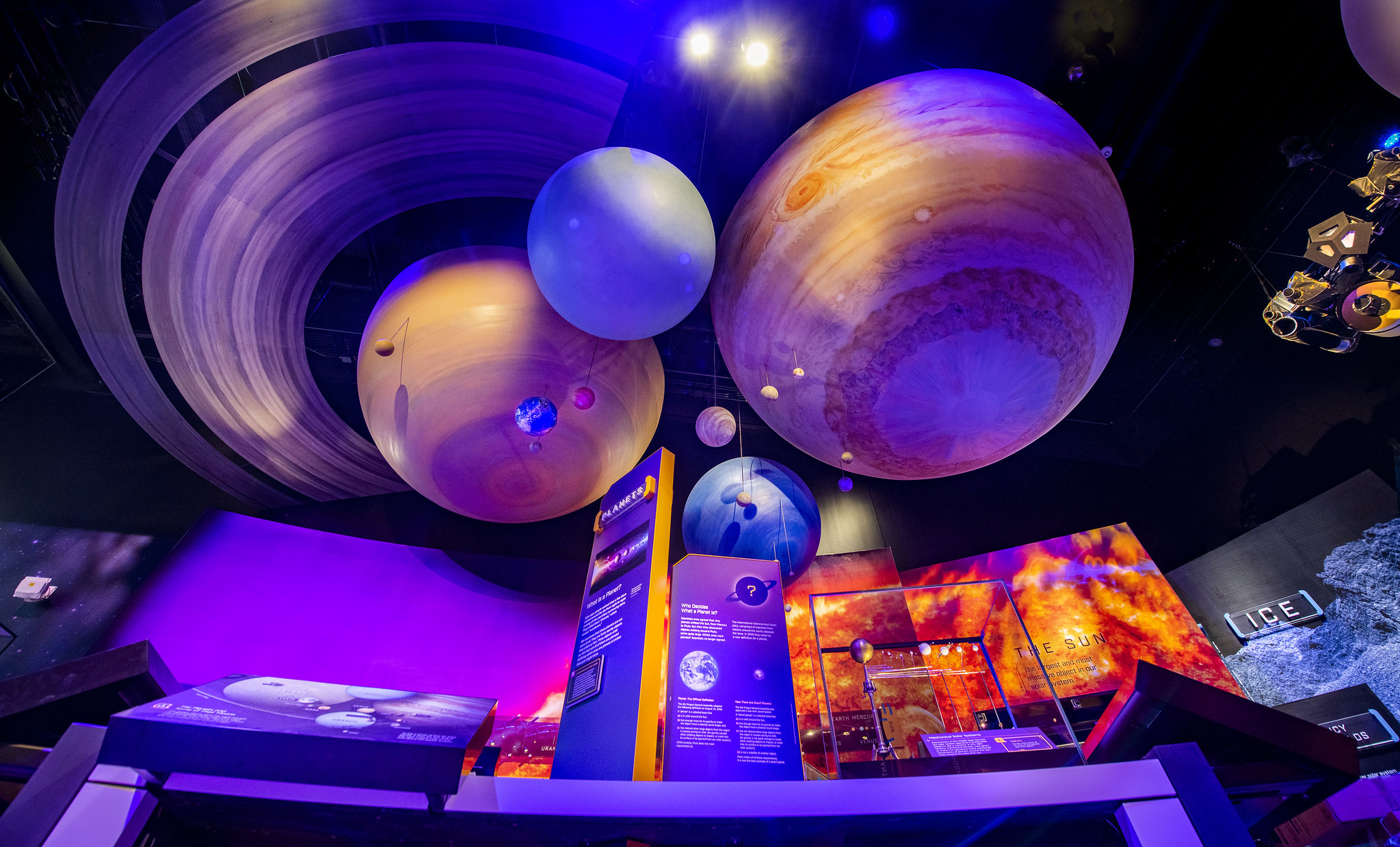“Kenneth C. Griffin Exploring the Planets Gallery”
Title: “Kenneth C. Griffin Exploring the Planets Gallery”
Opening: Oct. 14, 2022; National Air and Space Museum, Washington, D.C., Gallery 205
The “Kenneth C. Griffin Exploring the Planets Gallery” tells the stories of how exploration has revealed that the solar system is filled with amazingly diverse places that transform people’s understanding of Earth and worlds beyond. The solar system contains three types of worlds: giant planets, terrestrial planets and small icy/rocky bodies. Through the years, spacecraft cameras and instruments of increasing capability have revealed that the bright dots wandering in the sky are complex worlds, beautiful to the eye but often with environments of stark and dangerous extremes. With artifacts and interactives, the exhibition invites visitors to explore the solar system from the outside in.
Highlights include:
- “Marie Curie” Rover (Sojourner Flight Spare): Sojourner was the first successful Mars rover. It landed aboard the Pathfinder spacecraft July 4, 1997, and operated for 85 days. The Pathfinder mission tested the airbag landing system, cameras, rover mobility and other technology used for later Mars rovers.
- Mars Exploration Rover (MER) Test Bed: This rover was used on Earth to troubleshoot problems that the rovers on Mars encountered. Two MER rovers, named “Spirit” and “Opportunity,” landed on opposite sides of Mars in 2004. Those robotic “field geologists” used instruments to examine rocks and soils.
- Mars Science Laboratory Rover Full-Scale Model: The Mars Science Laboratory rover, named “Curiosity,” is much larger and better equipped than previous Mars rovers. “Curiosity” found sediments from former lakes and streams that could have supported bacterial life.
- Mariner 9 Photomosaic Globe: Mariner 9 studied Mars from orbit for nearly a year in 1971–1972. It sent back more than 7,000 television images that covered 85% of the planet’s surface. This globe was produced from Mariner 9 images.
- Stardust Return Capsule: Stardust was the first U.S. spacecraft to bring back material from beyond the moon. Seven years after its 1999 launch, Stardust passed by Earth and released the capsule, which parachuted onto the Utah desert.
- Voyager Spacecraft Full-Scale Mock-Up: Voyagers 1 and 2 explored Jupiter, Saturn, Uranus and Neptune. They examined the atmosphere, magnetic field and radiation belts of each planet. They also studied their ring systems and the surfaces and atmospheres of their many moons.
- Blink Comparator and Pluto Discovery Plates: To find Pluto, in 1930, Clyde Tombaugh used a blink comparator, switching the view back and forth between two photographic plates taken several days apart. The plates are exactly aligned so the distant stars remain stationary, but a planet-like object will appear to move from side to side among them. A blink comparator like the one Tombaugh used will be on display in the exhibition, along with a reproduction of the discovery plate.
- Spock Ears Tips: Leonard Nimoy used ear tips like these on display to transform into the half-human half Vulcan alien Mr. Spock in the Star Trek TV series; he brought this pair home from the set in the 1960s. This iconic science-fiction prop is new to the museum’s collection and serves to illustrate cultural imagination about possible life on other planets.
- Walking on Other Worlds Interactive: This immersive media exhibit presents visitors with a seven-minute “tour” of seven different worlds. Using a nearly 360-degree screen, it combines real data and images from spacecraft with CGI to produce an audiovisual experience that introduces visitors to the diversity of worlds in the solar system.
- Drive a Mars Rover Interactive: This interactive touchscreen experience challenges visitors to remotely navigate a Mars rover across the terrain through three missions. Along the way, they encounter obstacles and get to collect data.
Sponsor: Kenneth C. Griffin
“Kenneth C. Griffin Exploring the Planets Gallery” Curator Bios
Bob Craddock
Bob Craddock began his career as a geologist at the Center for Earth and Planetary Studies in 1988. While at the center, Craddock’s investigations have focused on understanding the geologic processes that have occurred on Mars. His work provided some of the first evidence that rain had fallen on the surface of early Mars. Through a joint appointment with the Department of Space History, Craddock works with curators in documenting and maintaining the National Collection of manned and unmanned planetary artifacts. From 2003 to 2004, he served in the Smithsonian’s Office of the Under Secretary for Science and Research as science advisor. In 2005, Craddock was elected chair of the Smithsonian Congress of Scholars, which is an internal organization dedicated to providing communication between the Smithsonian scholarly community and central administration. He received his Bachelor of Science in geology from University of Georgia, his master’s degree from Arizona State University and his doctorate from the University of Virginia.
Matthew Shindell
Matthew Shindell is a historian of science whose work focuses on the history of the Earth and planetary sciences, with an emphasis on the development of research programs in these fields during the Cold War. He curates the museum’s collection of spacecraft, instruments and other artifacts related to the exploration and study of the solar system. Shindell received a Bachelor of Science in biology from Arizona State University (1999), a Master of Fine Arts in creative writing from the University of Iowa Writers’ Workshop (2001), a Master of Science in biology: biology and society from Arizona State University (2004) and a doctorate in the history of science from the University of California, San Diego (2011).
# # #
SI-310-2022
Alison Wood
202-633-2376
Amy Stamm
202-633-2392

